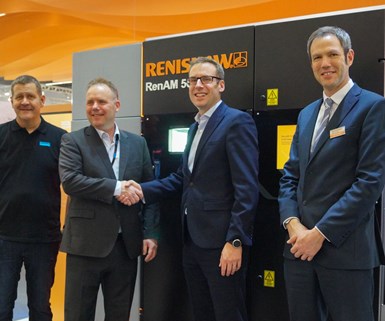Renishaw, Sandvik Collaborate on Validating AM Materials
Since 2018, the two companies have worked together to develop process parameters for a range of Sandvik metal powders.
Share
Read Next

Renishaw is collaborating with Sandvik Additive Manufacturing to qualify new additive manufacturing (AM) materials for production applications. The project encompasses a range of metal powders, including new alloy compositions that are optimized for the laser powder-bed fusion (LPBF) process.
Since 2018, the two companies have worked together to develop process parameters for a range of Sandvik metal powders, including stainless and maraging steels and Osprey nickel-based superalloys. Sandvik has recently launched a titanium atomizer and powder processing facility and will now turn its focus to qualifying these alloys for industrial and medical applications.
Mikael Schuisky, vice president of R&D and operations with Sandvik Additive Manufacturing, says, “Renishaw’s open machines have enabled us to rapidly optimize process parameters for our alloys for use in many different applications.” The company says that this parameter development work has highlighted opportunities to make small but important changes to the composition of Sandvik alloys while remaining within the relevant ASTM specification, thus optimizing the mechanical properties of LPBF components.
“Much of the innovation in AM in the next few years will come from the pairing of enhanced machine performance with improved alloys,” says Stephen Crownshaw, AM business nanager with Renishaw. “Better alloys mean better material properties, enabling AM components that are even more efficient and cost-effective.”
Related Content
-
DMG MORI: Build Plate “Pucks” Cut Postprocessing Time by 80%
For spinal implants and other small 3D printed parts made through laser powder bed fusion, separate clampable units resting within the build plate provide for easy transfer to a CNC lathe.
-
With Electrochemical Additive Manufacturing (ECAM), Cooling Technology Is Advancing by Degrees
San Diego-based Fabric8Labs is applying electroplating chemistries and DLP-style machines to 3D print cold plates for the semiconductor industry in pure copper. These complex geometries combined with the rise of liquid cooling systems promise significant improvements for thermal management.
-
3D Printed NASA Thrust Chamber Assembly Combines Two Metal Processes: The Cool Parts Show #71
Laser powder bed fusion and directed energy deposition combine for an integrated multimetal rocket propulsion system that will save cost and time for NASA. The Cool Parts Show visits NASA’s Marshall Space Flight Center.







